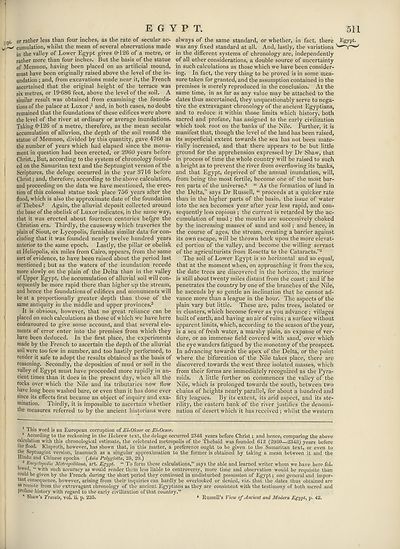Encyclopaedia Britannica > Volume 8, DIA-England
(521) Page 511
Download files
Complete book:
Individual page:
Thumbnail gallery: Grid view | List view

EGYPT.
.pu or rather less than four inches, as the rate of secular ac-
^ cumulation, whilst the mean of several observations made
in the valley of Lower Egypt gives 0*126 of a metre, or
rather more than four inches. But the basis of the statue
of Memnon, having been placed on an artificial mound,
must have been originally raised above the level of the in¬
undation ; and, from excavations made near it, the French
ascertained that the original height of the terrace was
six metres, or 19*686 feet, above the level of the soil. A
similar result was obtained from examining the founda¬
tions of the palace at Luxor and, in both cases, no doubt
remained that the foundations of these edifices were above
the level of the river at ordinary or average inundations.
Taking 0*126 of a metre, therefore, as the mean secular
accumulation of alluvion, the depth of the soil round the
statue of Memnon, divided by this quantity, gave 4760 as
the number of years which had elapsed since the monu¬
ment in question had been erected, or 2960 years before
Christ., But, according to the system of chronology found¬
ed on the Samaritan text and the Septuagint version of the
Scriptures, the deluge occurred in the year 3716 before
Christ; and, therefore, according to the above calculation,
and proceeding on the data we have mentioned, the erec¬
tion of this colossal statue took place 756 years after the
flood, which is also the approximate date of the foundation
of Thebes.1 2 Again, the alluvial deposit collected around
the base of the obelisk of Luxor indicates, in the same way,
that it was erected about fourteen centuries befpje the
Christian era. Thirdly, the causeway which traverses the
plain of Siout, or Lycopolis, furnishes similar data for con¬
cluding that it was founded nearly twelve hundred years
anterior to the same epoch. Lastly, the pillar or obelisk
at Heliopolis, six miles from Cairo, appears, from the same
sort of evidence, to have been raised about the period last
mentioned; but as the waters of the inundation recede
more slowly on the plain of the Delta than in the valley
of Upper Egypt, the accumulation of alluvial soil will con¬
sequently be more rapid there than higher up the stream,
and hence the foundations of edifices and monuments will
be at a proportionally greater depth than those of the
same antiquity in the middle and upper provinces.3
It is obvious, however, that no great reliance can be
placed on such calculations as those of which we have here
endeavoured to give some account, and that several ele¬
ments of error enter into the premises from which they
have been deduced. In the first place, the experiments
made by the French to ascertain the depth of the alluvial
soil were too few in number, and too hastily performed, to
render it safe to adopt the results obtained as the basis of
reasoning. Secondly, the deposition of mud or soil in the
valley of Egypt must have proceeded more rapidly in an¬
cient times than it does in the present day, when all the
rocks over which the Nile and its tributaries now flow
have long been washed bare, or even than it has done ever
since its effects first became an object of inquiry and exa¬
mination. Thirdly, it is impossible to ascertain whether
the measures referred to by the ancient historians were
511
always of the same standard, or whether, in fact, there Egypt,
was any fixed standard at all. And, lastly, the variations
in the different systems of chronology are, independently
of all other considerations, a double source of uncertainty
in such calculations as those which we have been consider¬
ing. In fact, the very thing to be proved is in some mea¬
sure taken for granted, and the assumption contained in the
premises is merely reproduced in the conclusion. At the
same time, in as far as any value may be attached to the
dates thus ascertained, they unquestionably serve to nega¬
tive the extravagant chronology of the ancient Egyptians,
and to reduce it within those limits which history, both
sacred and profane, has assigned to the early civilization
which took root on the banks of the Nile. Further, it is
manifest that, though the level of the land has been raised,
its superficial extent towards the sea has not been mate¬
rially increased, and that there appears to be but little
ground for the apprehension expressed by Dr Shaw, that
in process of time the whole country will be raised to such
a height as to prevent the river from overflowing its banks,
and that Egypt, deprived of the annual inundation, will,
from being the most fertile, become one of the most bar¬
ren parts of the universe.4 “ As the formation of land in
the Delta,” says Dr Russell, “ proceeds at a quicker rate
than in the higher parts of the basin, the issue of water
into the sea becomes year after year less rapid, and con¬
sequently less copious ; the current is retarded by the ac¬
cumulation of mud ; the mouths are successively choked
by the increasing masses of sand and soil; and hence, in
the course of ages, the stream, creating a barrier against
its own escape, will be thrown back upon the more elevat¬
ed portion of the valley, and become the willing servant
of the agriculturists from Rosetta to the Cataracts.”5
The soil of Lower Egypt is so horizontal and so equal,
that at the moment when, on approaching it from the sea,
the date trees are discovered in the horizon, the mariner
is still about twenty miles distant from the coast; and if he
penetrates the country by one of the branches of the Nile,
he ascends by so gentle an inclination that he cannot ad¬
vance more than a league in the hour. The aspects of the
plain vary but little. These are, palm trees, isolated or
in clusters, which become fewer as you advance ; villages
built of earth, and having an air of ruins; a surface without
apparent limits, which, according to the season of the year,
is a sea of fresh water, a marshy plain, an expanse of ver¬
dure, or an immense field covered with sand, over which
the eye wanders fatigued by the monotony of the prospect.
In advancing towards the apex of the Delta, or the point
where the bifurcation of the Nile takes place, there are
discovered towards the west three isolated masses, which
from their forms are immediately recognized as the Pyra¬
mids. A little further on commences the valley of the
Nile, which is prolonged towards the south, between two
chains of heights nearly parallel, for about a hundred and
fifty leagues. By its extent, its arid aspect, and its ste-
rility, the eastern bank of the river justifies the denomi¬
nation of desert which it has received ; whilst the western
1 This word is an European corruption of El-Oksor or El-Ocsor.
* According to the reckoning in the Hebrew text, the deluge occurred 2348 years before Christ; and hence, comparing the above
calculation with this chronological estimate, the celebrated metropolis of the Thebaid was founded 812 (2980—2348) years before
the flood. Klaproth, however, has shown that, in this matter, a preference ought to be given to the Samaritan text, or even to
the Septuagint version, inasmuch as a singular approximation to the former is obtained by taking a mean between it and the
Hindu and Chinese epochs. (Asia Polyglotta, 25, 29.)
3 Encyclopedia Metropolitana, art. Egypt. “ To form these calculations,” says the able and learned writer whom we have here fol¬
lowed, with such accuracy as would render them less liable to controversy, more time and observation would be requisite than
could be given by the French during the short period they continued in undisturbed possession of Egypt; one general and impor¬
tant consequence, however, arising from their inquiries can hardly be overlooked or denied, viz. that the dates thus obtained are
as remote trom the extravagant chronology of the ancient Egyptians as they are consistent with the testimony of both sacred and
profane history with regard to the early civilization of that country.”
4 Shaw’s Travels, vol. ii. p. 235. 4 Russell's View of Ancient and Modern Egypt, p. 42.
.pu or rather less than four inches, as the rate of secular ac-
^ cumulation, whilst the mean of several observations made
in the valley of Lower Egypt gives 0*126 of a metre, or
rather more than four inches. But the basis of the statue
of Memnon, having been placed on an artificial mound,
must have been originally raised above the level of the in¬
undation ; and, from excavations made near it, the French
ascertained that the original height of the terrace was
six metres, or 19*686 feet, above the level of the soil. A
similar result was obtained from examining the founda¬
tions of the palace at Luxor and, in both cases, no doubt
remained that the foundations of these edifices were above
the level of the river at ordinary or average inundations.
Taking 0*126 of a metre, therefore, as the mean secular
accumulation of alluvion, the depth of the soil round the
statue of Memnon, divided by this quantity, gave 4760 as
the number of years which had elapsed since the monu¬
ment in question had been erected, or 2960 years before
Christ., But, according to the system of chronology found¬
ed on the Samaritan text and the Septuagint version of the
Scriptures, the deluge occurred in the year 3716 before
Christ; and, therefore, according to the above calculation,
and proceeding on the data we have mentioned, the erec¬
tion of this colossal statue took place 756 years after the
flood, which is also the approximate date of the foundation
of Thebes.1 2 Again, the alluvial deposit collected around
the base of the obelisk of Luxor indicates, in the same way,
that it was erected about fourteen centuries befpje the
Christian era. Thirdly, the causeway which traverses the
plain of Siout, or Lycopolis, furnishes similar data for con¬
cluding that it was founded nearly twelve hundred years
anterior to the same epoch. Lastly, the pillar or obelisk
at Heliopolis, six miles from Cairo, appears, from the same
sort of evidence, to have been raised about the period last
mentioned; but as the waters of the inundation recede
more slowly on the plain of the Delta than in the valley
of Upper Egypt, the accumulation of alluvial soil will con¬
sequently be more rapid there than higher up the stream,
and hence the foundations of edifices and monuments will
be at a proportionally greater depth than those of the
same antiquity in the middle and upper provinces.3
It is obvious, however, that no great reliance can be
placed on such calculations as those of which we have here
endeavoured to give some account, and that several ele¬
ments of error enter into the premises from which they
have been deduced. In the first place, the experiments
made by the French to ascertain the depth of the alluvial
soil were too few in number, and too hastily performed, to
render it safe to adopt the results obtained as the basis of
reasoning. Secondly, the deposition of mud or soil in the
valley of Egypt must have proceeded more rapidly in an¬
cient times than it does in the present day, when all the
rocks over which the Nile and its tributaries now flow
have long been washed bare, or even than it has done ever
since its effects first became an object of inquiry and exa¬
mination. Thirdly, it is impossible to ascertain whether
the measures referred to by the ancient historians were
511
always of the same standard, or whether, in fact, there Egypt,
was any fixed standard at all. And, lastly, the variations
in the different systems of chronology are, independently
of all other considerations, a double source of uncertainty
in such calculations as those which we have been consider¬
ing. In fact, the very thing to be proved is in some mea¬
sure taken for granted, and the assumption contained in the
premises is merely reproduced in the conclusion. At the
same time, in as far as any value may be attached to the
dates thus ascertained, they unquestionably serve to nega¬
tive the extravagant chronology of the ancient Egyptians,
and to reduce it within those limits which history, both
sacred and profane, has assigned to the early civilization
which took root on the banks of the Nile. Further, it is
manifest that, though the level of the land has been raised,
its superficial extent towards the sea has not been mate¬
rially increased, and that there appears to be but little
ground for the apprehension expressed by Dr Shaw, that
in process of time the whole country will be raised to such
a height as to prevent the river from overflowing its banks,
and that Egypt, deprived of the annual inundation, will,
from being the most fertile, become one of the most bar¬
ren parts of the universe.4 “ As the formation of land in
the Delta,” says Dr Russell, “ proceeds at a quicker rate
than in the higher parts of the basin, the issue of water
into the sea becomes year after year less rapid, and con¬
sequently less copious ; the current is retarded by the ac¬
cumulation of mud ; the mouths are successively choked
by the increasing masses of sand and soil; and hence, in
the course of ages, the stream, creating a barrier against
its own escape, will be thrown back upon the more elevat¬
ed portion of the valley, and become the willing servant
of the agriculturists from Rosetta to the Cataracts.”5
The soil of Lower Egypt is so horizontal and so equal,
that at the moment when, on approaching it from the sea,
the date trees are discovered in the horizon, the mariner
is still about twenty miles distant from the coast; and if he
penetrates the country by one of the branches of the Nile,
he ascends by so gentle an inclination that he cannot ad¬
vance more than a league in the hour. The aspects of the
plain vary but little. These are, palm trees, isolated or
in clusters, which become fewer as you advance ; villages
built of earth, and having an air of ruins; a surface without
apparent limits, which, according to the season of the year,
is a sea of fresh water, a marshy plain, an expanse of ver¬
dure, or an immense field covered with sand, over which
the eye wanders fatigued by the monotony of the prospect.
In advancing towards the apex of the Delta, or the point
where the bifurcation of the Nile takes place, there are
discovered towards the west three isolated masses, which
from their forms are immediately recognized as the Pyra¬
mids. A little further on commences the valley of the
Nile, which is prolonged towards the south, between two
chains of heights nearly parallel, for about a hundred and
fifty leagues. By its extent, its arid aspect, and its ste-
rility, the eastern bank of the river justifies the denomi¬
nation of desert which it has received ; whilst the western
1 This word is an European corruption of El-Oksor or El-Ocsor.
* According to the reckoning in the Hebrew text, the deluge occurred 2348 years before Christ; and hence, comparing the above
calculation with this chronological estimate, the celebrated metropolis of the Thebaid was founded 812 (2980—2348) years before
the flood. Klaproth, however, has shown that, in this matter, a preference ought to be given to the Samaritan text, or even to
the Septuagint version, inasmuch as a singular approximation to the former is obtained by taking a mean between it and the
Hindu and Chinese epochs. (Asia Polyglotta, 25, 29.)
3 Encyclopedia Metropolitana, art. Egypt. “ To form these calculations,” says the able and learned writer whom we have here fol¬
lowed, with such accuracy as would render them less liable to controversy, more time and observation would be requisite than
could be given by the French during the short period they continued in undisturbed possession of Egypt; one general and impor¬
tant consequence, however, arising from their inquiries can hardly be overlooked or denied, viz. that the dates thus obtained are
as remote trom the extravagant chronology of the ancient Egyptians as they are consistent with the testimony of both sacred and
profane history with regard to the early civilization of that country.”
4 Shaw’s Travels, vol. ii. p. 235. 4 Russell's View of Ancient and Modern Egypt, p. 42.
Set display mode to:
![]() Universal Viewer |
Universal Viewer | ![]() Mirador |
Large image | Transcription
Mirador |
Large image | Transcription
Images and transcriptions on this page, including medium image downloads, may be used under the Creative Commons Attribution 4.0 International Licence unless otherwise stated. ![]()
| Encyclopaedia Britannica > Encyclopaedia Britannica > Volume 8, DIA-England > (521) Page 511 |
|---|
| Permanent URL | https://digital.nls.uk/193329778 |
|---|
| Attribution and copyright: |
|
|---|
| Description | Ten editions of 'Encyclopaedia Britannica', issued from 1768-1903, in 231 volumes. Originally issued in 100 weekly parts (3 volumes) between 1768 and 1771 by publishers: Colin Macfarquhar and Andrew Bell (Edinburgh); editor: William Smellie: engraver: Andrew Bell. Expanded editions in the 19th century featured more volumes and contributions from leading experts in their fields. Managed and published in Edinburgh up to the 9th edition (25 volumes, from 1875-1889); the 10th edition (1902-1903) re-issued the 9th edition, with 11 supplementary volumes. |
|---|---|
| Additional NLS resources: |
|

